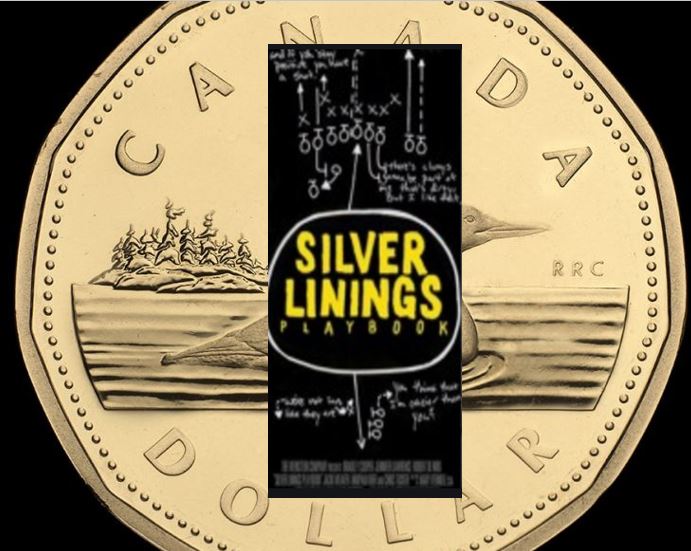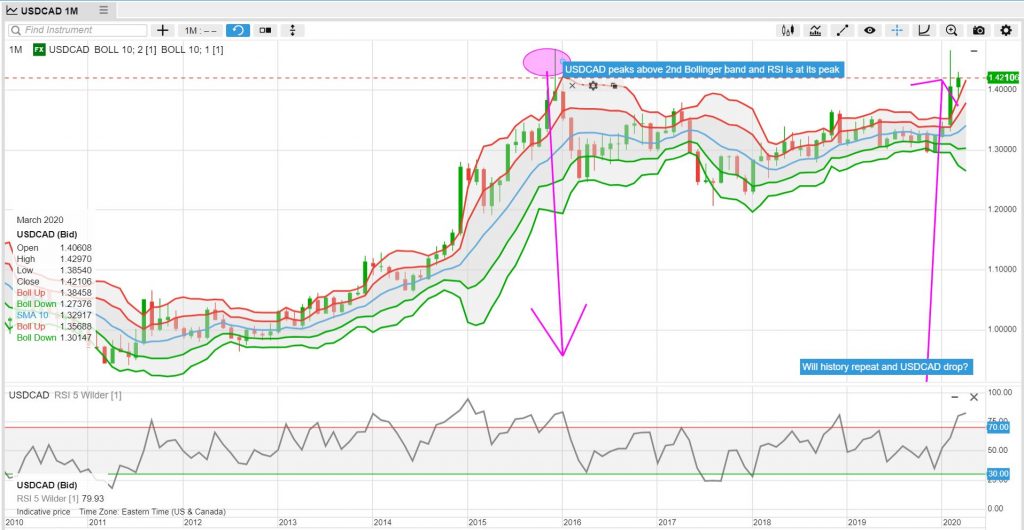
By Michael O’Neill
It is said that “every cloud has a silver lining.” For Canadian individuals and corporations with US dollar receivables, the coronavirus pandemic may be their silver lining.
World leaders and the G-7 Finance ministers reacted quickly, and quite decisively once the COVID-19 outbreak was declared a pandemic. Governments enforced strict personal isolation and lock-down measures while closing non-essential business. They followed up those moves with unprecedented spending measures which ballooned government deficits. Central Banks slashed interest rates and re-opened quantitative easing programs (QE), pumping trillions of dollars of liquidity into markets.
Those actions had various measures of success. The Dow Jones Industrial Average which lost 37% of its value between February 20 and March 23, recouped 25% of the losses in response to the government and central bank initiatives.
Chart: DJIA Mid-Jan to April 21, 2020

The Bank of Canada cut interest rates three times, slashing rates from 1.75% to 0.25%. The BoC also announced a new QE program that includes buying of provincial bonds and corporate bonds. On its own, those actions would be reason enough to buy USDCAD.
However, the BoC was just following in the footsteps of the other G-7 central banks. The RBA and RBNZ adopted similar measures, and the ECB launched a €750 billion QE program.
The US Federal Reserve started it all with an emergency 0.5% rate cut on March 3. By April 9, the Fed had announced a $2.3 trillion lending program to extend credit to banks for Paycheck Protection Program (PPP) loans, and an expansion of the QE program to unlimited from $750 billion.
The result was the Fed’s actions overshadowed those of the other G-7 central banks, and the US dollar rallied on the back of safe-haven demand.
At the height of the pandemic, one-third of the planet’s population was in a lock-down. China got the ball rolling, locking down Wuhan, and its province, Hubei. Italy and Spain were at the forefront of lock-downs in Europe, while Canada and the US implemented restrictions around the middle of March. Those restrictions are beginning to ease.
The jury is still out, but the “stay-ate-home” initiatives are showing signs of success as the number of COVID-19 cases in Canada, and in other countries, appears to have plateaued. Political leaders are eager to re-open their economies but leery of doing it too soon.
The combination of multi-trillion dollar stimulus spending and the power of the global scientific community working towards a cure may have beaten the coronavirus into submission. It has also “changed the world as we know it,” but it’s too early to know if “we’ll feel fine.”
USDCAD rose 10% since the end of February due to safe-haven demand for US dollars, with a dash of oil price angst added in for good measure. Although it has pared those gains, it is still up 6.7% as of April 21, which may be a hedging opportunity for Canadian corporations with US dollar receivables.
It isn’t an easy decision. Shakespeare’s Hamlet struggled with the question “to be or not be.” Individual and corporate treasurer’s dilemma is “to hedge or not to hedge.”
Reasons to hedge (sell USDCAD)
- The BoC monetary policy statement said that Canada entered the COVID-19 crisis in a solid position, which suggests an economic rebound could be quicker than expected
- USDCAD strength following the drop in WTI prices below $0 is an anomaly, more of a technical factor than evidence of a collapse in the global oil industry.
- USDCAD selling pressure will be exacerbated by an early opening of the US economy, and robust US economic rebound.
- Long term USDCAD technicals show prices at lofty levels and very vulnerable to a steep, rapid correction.
Reasons not to hedge: (sit on US dollar balances)
- A prolonged slump in WTI oil prices below $30.00/b may underpin USDCAD.
- Bank of Canada Governor Stephen Poloz retires on June 2. His offer to extend his tenure was turned down by the Trudeau government. A new, inexperienced, and unknown replacement may unsettle markets and underpin USDCAD.
- The BoC’s worst-case forecast for 2020 GDP growth is -19% according to TC GlobalMacro, which may dissuade investors from Canadian investments.
The long term USDCAD technicals are bearish as shown by the following monthly, 10-year chart. USDCAD is trading above the top Bollinger band, or two standard deviations from its smooth moving average. The deviation is an indication that prices are at an elevated level, and as the chart shows, prices don’t stay above this level very long. The Relative Strength Indicator (RSI) supports this view.
Chart: USDCAD 1 month-10year with Bollinger bands (red and green) and RSI shown

Source: Saxo Bank
Hedging Strategy for those who are long US dollars against Canadian dollars
A simple, popular, and effective hedging strategy utilized by many corporations to protect future US dollar inflows is to enter a series of forward contracts. (Forwards are legal contracts between two parties to sell an agreed amount of, in this case, US dollars at a specified USDCAD exchange rate, for delivery on a pre-agreed date in the future.)
For example, Hedgemaster Inc knows for 100% certainty that they will receive USD $100,000 on May 26, June 26, and July 27, 2020. They also know that the current USDCAD exchange rate is well above the company’s budgeted rate for 2020. They decide to sell their next three months worth of US dollar receivables at the current exchange rate for delivery on the May, June, July dates.
Assumptions: Spot rate 1.4220, Forward discounts of .0004 for 1 month, .0007 for 2 months and .0014 for 3 months. (Note: Forward rates are not penalties. Simply speaking, they are merely the interest rate differentials between Canada and the US converted to FX points).
In the above example, Customer A would book three FX forwards today and be obligated to deliver $100,000 US dollars to AgilityForex on May 26, June 26, and July 27, receiving CAD$ 143,160.00, CAD$143,130.00 and CAD 143,060.00, respectively.
If USDCAD is trading at 1.3500 on May 26, Customer A would be ecstatic. If rates are above 1.4216, the client loses the opportunity to sell at a more favourable rate as he is locked into the forward rate. He is still happy because the price is above his budget target.
If these gains help mitigate costs associated with managing the business during the COVID-19 outbreak, that would be the silver lining.





